Development of Novel Ceramic Microstructures from Sintered Biomass and Fly Ash Mixtures: Promoting Sustainability and Health
Abstract
:1. Introduction
2. Materials and Methods
2.1. Raw Materials
2.2. Sample Preparation
2.3. Instrumental Analysis
3. Results and Discussion
4. Conclusions
Author Contributions
Funding
Institutional Review Board Statement
Informed Consent Statement
Data Availability Statement
Conflicts of Interest
Abbreviations
| OKA | Olive kernel biomass ash |
| FAAD | Highly-calcareous fly ash |
| FAM | Siliceous fly ash |
| XRD | X-ray diffraction |
| SEM | Scanning electron microscopy |
| EDAX | Energy-dispersive X-ray spectroscopy |
References
- Donner, M.; Erraach, Y.; Gelats, F.; Martin, J.; Yatribi, T.; Radic, I.; El Hadad-Gaultier, F. Circular bioeconomy for olive oil waste and by-product valorisation: Actors’ strategies and conditions in the Mediterranean area. J. Environ. Manag. 2022, 321, 115836. [Google Scholar] [CrossRef]
- Kulczycka, J.; Lewandowska, A.; Joachimiak-Lechman, K.; Kurczewski, P. The Circularity of Materials from the Perspective of the Product Life Cycle: A Case Study of Secondary Fence Board, Part 2 (Scenario Analysis). Resources 2024, 13, 52. [Google Scholar] [CrossRef]
- Frías, M.; Moreno de los Reyes, A.M.; Villar-Cociña, E.; García, R.; Vigil de la Villa, R.; Vasić, M.V. New Eco-Cements Made with Marabou Weed Biomass Ash. Materials 2024, 17, 5012. [Google Scholar] [CrossRef] [PubMed]
- Karayannis, V.G.; Moutsatsou, A.K.; Baklavaridis, A.N.; Katsika, E.L.; Domopoulou, A.E. Synergistic Sintering of Lignite Fly Ash and Steelmaking Residues towards Sustainable Compacted Ceramics. Adv. Mater. Sci. Eng. 2017, 2017, 1735268. [Google Scholar] [CrossRef]
- Singh, J.; Boddula, R.; Jirimali, H.D. Utilization of secondary agricultural products for the preparation of value added silica materials and their important applications: A review. J. Sol-Gel Sci. Technol. 2020, 96, 15–33. [Google Scholar] [CrossRef]
- Muñoz, P.; Letelier, V.; Muñoz, L.; Gencel, O.; Sutcu, M.; Vasic, M. Assessing technological properties and environmental impact of fired bricks made by partially adding bottom ash from an industrial approach. Constr. Build. Mater. 2023, 396, 132338. [Google Scholar] [CrossRef]
- Ioannidou, O.A.; Zabaniotou, A.A.; Stavropoulos, G.G.; Islam, M.A.; Albanis, T.A. Preparation of activated carbons from agricultural residues for pesticide adsorption. Chemosphere 2010, 80, 1328–1336. [Google Scholar] [CrossRef]
- Lila, K.; Belaadi, S.; Solimando, R.; Zirour, F. Valorisation of organic waste: Use of olive kernels and pomace for cement manufacture. J. Clean. Prod. 2020, 277, 123703. [Google Scholar] [CrossRef]
- Martin, J.F.G.; Cuevas, M.; Feng, C.H.; Mateos, P.A.; Garcia, M.T.; Sanchez, S. Energetic Valorisation of Olive Biomass: Olive-Tree Pruning, Olive Stones and Pomaces. Processes 2020, 8, 511. [Google Scholar] [CrossRef]
- Calvano, C.; Tamborrino, A. Valorization of Olive By-Products: Innovative Strategies for Their Production, Treatment and Characterization. Foods 2022, 11, 768. [Google Scholar] [CrossRef]
- Pagonis, N.; Flegkas, D.; Itziou, A.; Kountouras, K.; Stimoniaris, A.; Samaras, P.; Karayannis, V. Upcycling of Eggshell Waste into Calcium Phosphates for Use in Sustainable Biomedical Engineering Applications. Eng 2024, 5, 3540–3550. [Google Scholar] [CrossRef]
- Papachristopoulos, E.; Tsiaras, E.; Papadakis, V.; Coutelieris, F. Design of a Biogas Power Plant That Uses Olive Tree Pruning and Olive Kernels in Achaia, Western Greece. Sustainability 2024, 16, 187. [Google Scholar] [CrossRef]
- Tzathas, K.; Chrysagi, E.; Lyberatos, G.; Vlyssides, A.; Vlysidis, A. Pretreatment of Olive Mill Wastes for the Extraction of Residual Oil and High Added Value Compounds. Waste Biomass Valorization 2019, 11, 4025–4034. [Google Scholar] [CrossRef]
- Vasilatos, C.; Kypritidou, Z.; Anastasatou, M.; Aspiotis, K. Sustainable Restoration of Depleted Quarries by the Utilization of Biomass Energy By-Products: The Case of Olive Kernel Residuals. Sustainability 2023, 15, 1642. [Google Scholar] [CrossRef]
- Arabani, M.H.; Hassanjani, M.H.; Farkhondeh, J.; Taleghani, M.Y. Enhancing mechanical properties of hot mix asphalt with olive kernel ash: A sustainable modifier. Constr. Build. Mater. 2024, 451, 138740. [Google Scholar] [CrossRef]
- Arabani, M.; Hassanjani, M.H. The influence of olive kernel ash obtained from canning factory as a bitumen modifier. Constr. Build. Mater. 2024, 441, 137532. [Google Scholar] [CrossRef]
- Alonso, M.M.; Gascó, C.; Morales, M.M.; Suárez-Navarro, J.A.; Zamorano, M.; Puertas, F. Olive biomass ash as an alternative activator in geopolymer formation: A study of strength, radiology and leaching behavior. Cem. Concr. Compos. 2019, 104, 103384. [Google Scholar] [CrossRef]
- Naqvi, S.Z.; Ramkumar, J.; Kar, K.K. Coal-based fly ash. In Handbook of Fly Ash; Kar, K.K., Ed.; Butterworth-Heinemann: Oxford, UK, 2022; pp. 3–33. [Google Scholar] [CrossRef]
- ASTM 618; Standard Specification for Coal Fly Ash and Raw or Calcined Natural Pozzolan for Use in Concrete. ASTM: West Conshohocken, PA, USA, 2023.
- Danish, A.; Mosaberpanah, M.A. Formation mechanism and applications of cenospheres: A review. J. Mater. Sci. 2020, 55, 4539–4557. [Google Scholar] [CrossRef]
- Ranjbar, N.; Kuenzel, C. Cenospheres: A review. Fuel 2017, 207, 1–12. [Google Scholar] [CrossRef]
- Jayaranjan, M.L.D.; van Hullebusch, E.D.; Annachhatre, A.P. Reuse options for coal fired power plant bottom ash and fly ash. Rev. Environ. Sci. Bio/Technol. 2014, 13, 467–486. [Google Scholar] [CrossRef]
- Valt, K.; Aggeli, E.; Papadaskalopoulou, C.; Panaretou, V.; Sotiropoulos, A.; Malamis, D.; Moustakas, K.; Haralambous, K. Adding Value to Olive Oil Production Through Waste and Wastewater Treatment and Valorisation: The Case of Greece. Waste Biomass Valorization 2015, 6, 913–925. [Google Scholar] [CrossRef]
- Sani, R.; Nzihou, A. Production of clay ceramics using agricultural wastes: Study of properties, energy savings and environmental indicators. Appl. Clay Sci. 2017, 146, 106–114. [Google Scholar] [CrossRef]
- Vasilatos, C.; Dimitris, C.; Theodorou, T.; Stouraiti, C.; Andreadi, M.; Koukouzas, N. A Comparative Study of Selected Properties of Biomass and Coal Fuels from Greece. Mater. Proc. 2021, 5, 108. [Google Scholar] [CrossRef]
- Abdelmagid, A.A.A.; Idriss, A.I.B.; Yang, C.M. Effects of Particle Size on Mechanical Properties and Forming Accuracy of Prosopis chilensis Powder/Polyethersulfone Composites Produced via Selective Laser Sintering. Polymers 2024, 16, 1786. [Google Scholar] [CrossRef]
- Łagodzińska, P.; Dejak, B.; Krasowski, M.; Konieczny, B. The Influence of Alumina Airborne-Particle Abrasion with Various Sizes of Alumina Particles on the Phase Transformation and Fracture Resistance of Zirconia-Based Dental Ceramics. Materials 2023, 16, 5419. [Google Scholar] [CrossRef]
- Shishkin, A.; Abramovskis, V.; Zalite, I.; Singh, A.K.; Mezinskis, G.; Popov, V.; Ozolins, J. Physical, Thermal, and Chemical Properties of Fly Ash Cenospheres Obtained from Different Sources. Materials 2023, 16, 2035. [Google Scholar] [CrossRef]
- Jambhulkar, H.P.; Shaikh, S.M.S.; Kumar, M.S. Fly ash toxicity, emerging issues and possible implications for its exploitation in agriculture; Indian scenario: A review. Chemosphere 2018, 213, 333–344. [Google Scholar] [CrossRef]
- Asl, S.M.H.; Ghadi, A.; Baei, M.S.; Javadian, H.; Maghsudi, M.; Kazemian, H. Porous catalysts fabricated from coal fly ash as cost-effective alternatives for industrial applications: A review. Fuel 2018, 217, 320–342. [Google Scholar] [CrossRef]
- Ge, J.C.; Yoon, S.K.; Choi, N.J. Application of Fly Ash as an Adsorbent for Removal of Air and Water Pollutants. Appl. Sci. 2018, 8, 1116. [Google Scholar] [CrossRef]
- Gadore, V.; Ahmaruzzaman, M. Fly ash–based nanocomposites: A potential material for effective photocatalytic degradation/elimination of emerging organic pollutants from aqueous stream. Environ. Sci. Pollut. Res. 2021, 28, 46910–46933. [Google Scholar] [CrossRef]
- Riccioti, L.; Apicella, A.; Perrotta, V.; Aversa, R. Geopolymer Materials for Bone Tissue Applications: Recent Advances and Future Perspectives. Polymers 2023, 15, 1087. [Google Scholar] [CrossRef]
- Yeung, K.W.; Tang, C.Y.; Hu, R.; Lam, C.H.; Law, W.C.; Tsui, G.C.P.; Zhao, X.; Chung, J.K.H. Fabrication of ceramic bioscaffolds from fly ash cenosphere by susceptor-assisted microwave sintering. J. Eur. Ceram. Soc. 2022, 42, 4410–4419. [Google Scholar] [CrossRef]
- Candeiro, G.T.M.; Moura-Netto, C.; D’Almeida-Couto, R.S.; Azambuja-Júnior, N.; Marques, M.M.; Cai, S.; Gavini, G. Cytotoxicity, genotoxicity and antibacterial effectiveness of a bioceramic endodontic sealer. Int. Endod. J. 2016, 49, 858–864. [Google Scholar] [CrossRef] [PubMed]
- Radwanski, M.; Rozpedek-Kaminska, W.; Galita, G.; Siwecka, N.; Sokolowski, J.; Majsterek, I.; Özcan, M.; Lukomska-Szymanska, M. Cytotoxicity and genotoxicity of bioceramic root canal sealers compared to conventional resin-based sealer. Sci. Rep. 2024, 14, 4124. [Google Scholar] [CrossRef]
- Thrivikraman, G.; Madras, G.; Basu, B. In vitro / In vivo assessment and mechanisms of toxicity of bioceramic materials and its wear particulates. RSC Adv. 2014, 4, 12763–12781. [Google Scholar] [CrossRef]
- Wang, S.; Xie, H.; Wei, H.; Xing, P.; Zhuang, Y. Recycling B4C grinding waste to fabricate high-performance ceramics by modification treatments and hot pressing. J. Environ. Manag. 2024, 371, 123230. [Google Scholar] [CrossRef]
- Biesuza, M.; Sglavo, V.M. Flash sintering of ceramics. J. Eur. Ceram. Soc. 2019, 39, 115–143. [Google Scholar] [CrossRef]
- Ćurković, L.; Veseli, R.; Gabelica, I.; Žmak, I.; Ropuš, I.; Vukšić, M. A Review of Microwave-Assisted Sintering Technique. Trans. FAMENA 2021, 45, 1–16. [Google Scholar] [CrossRef]

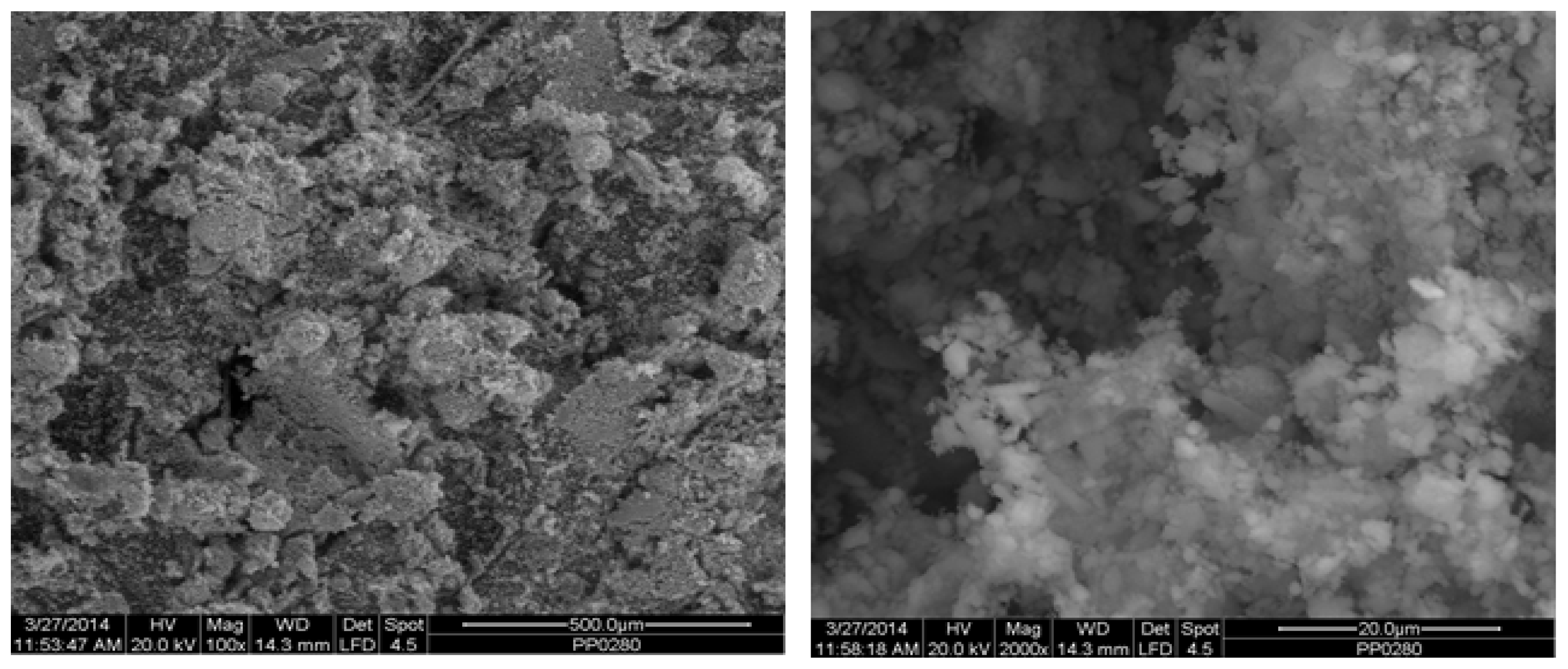
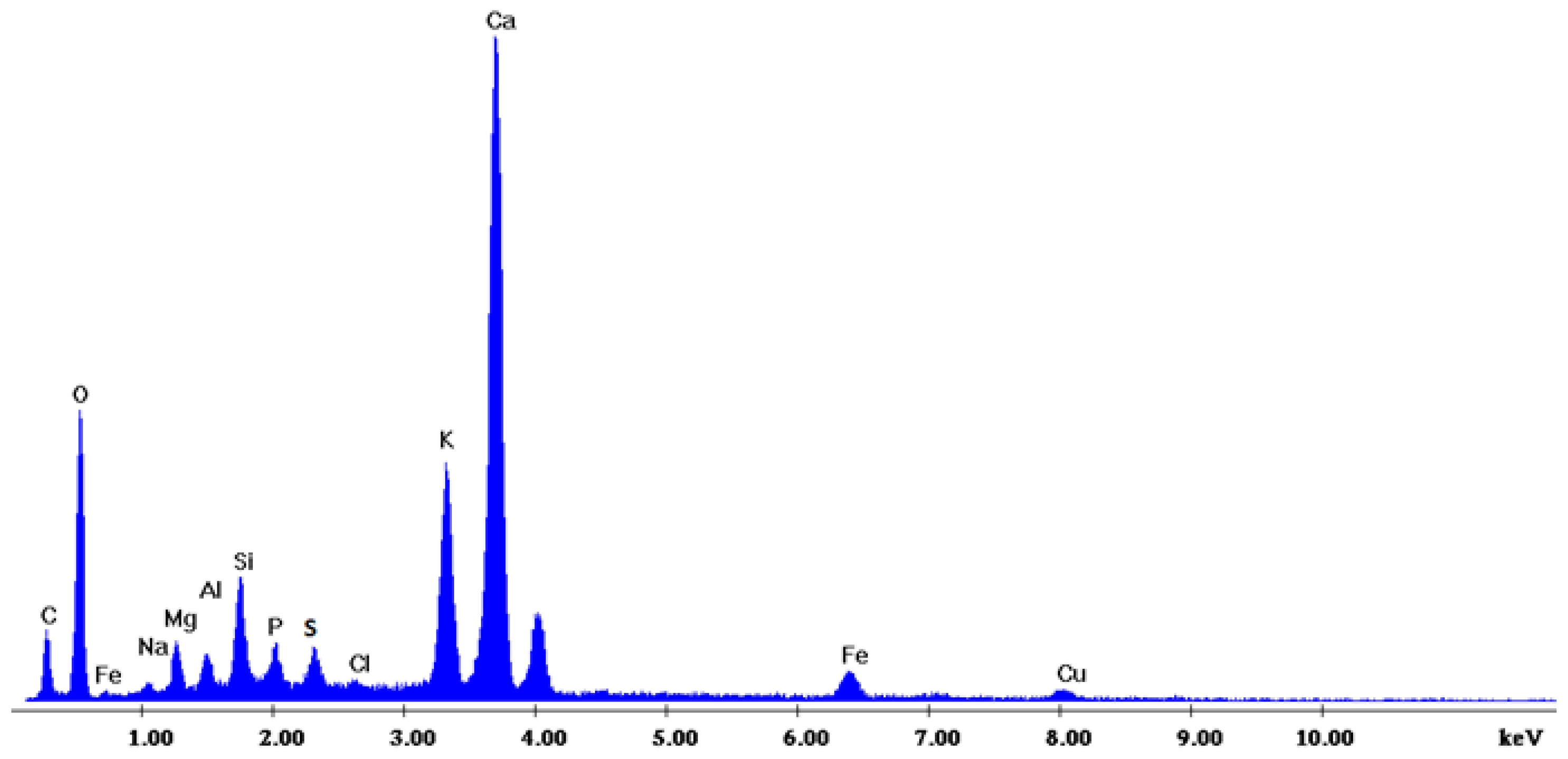
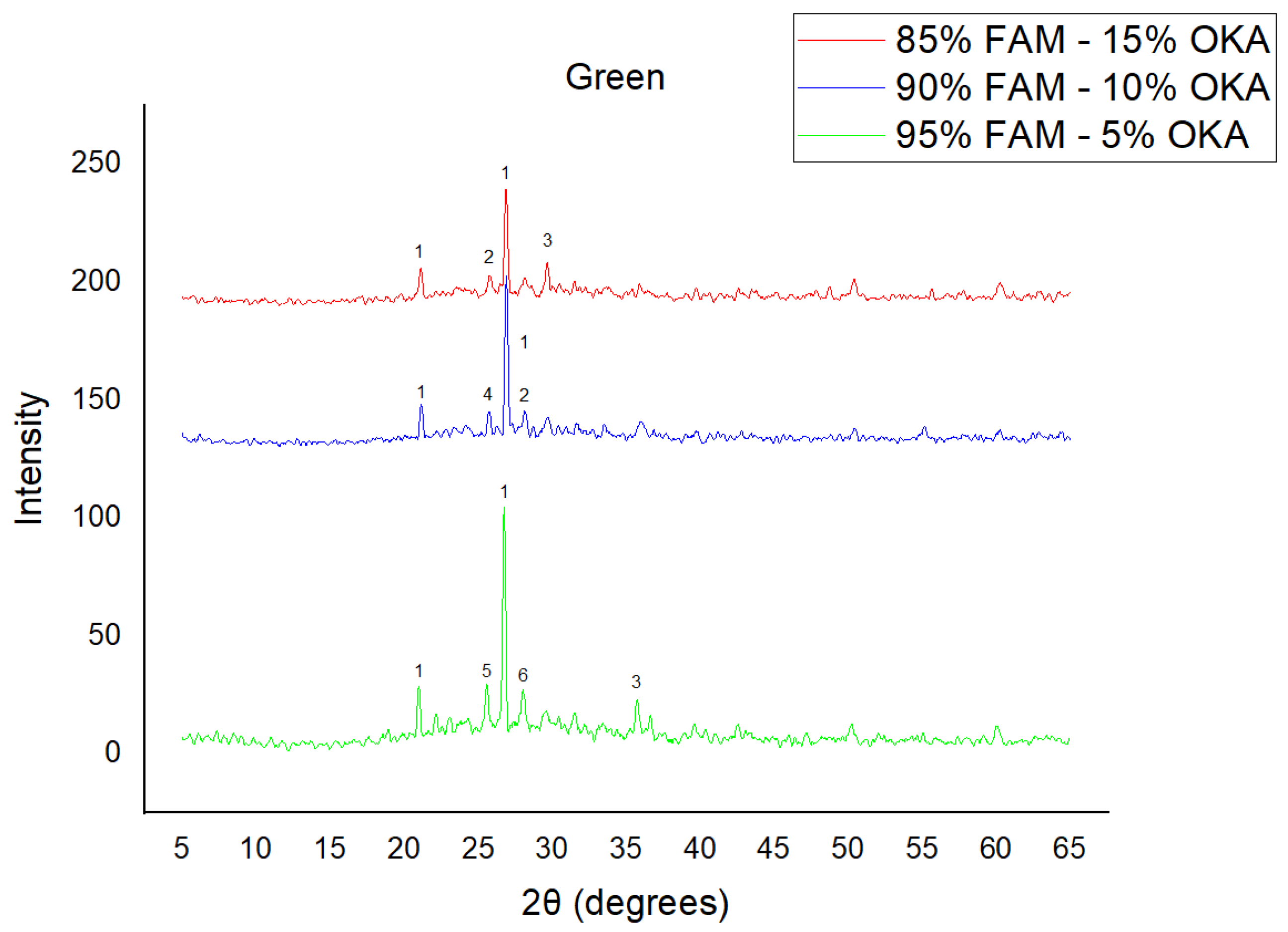
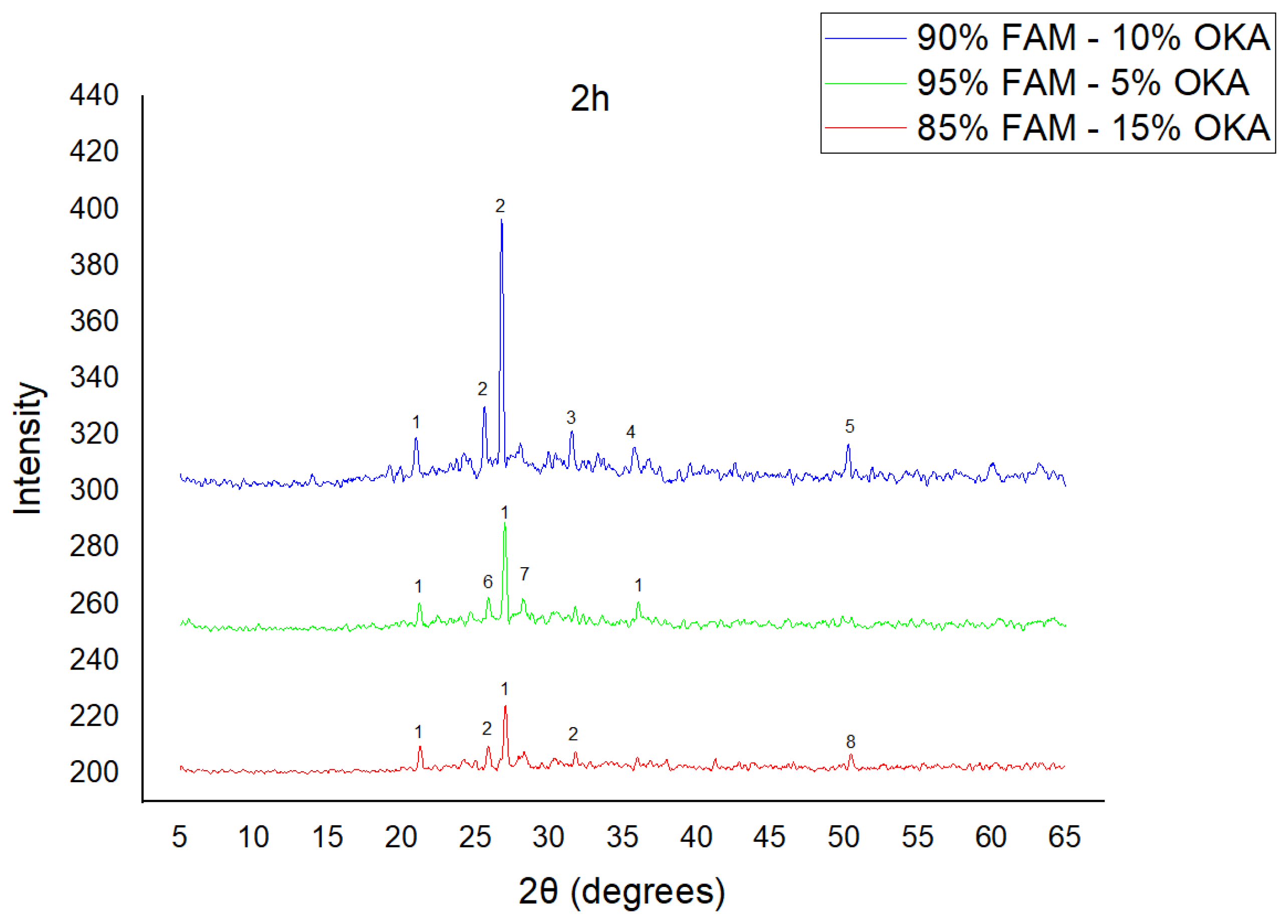
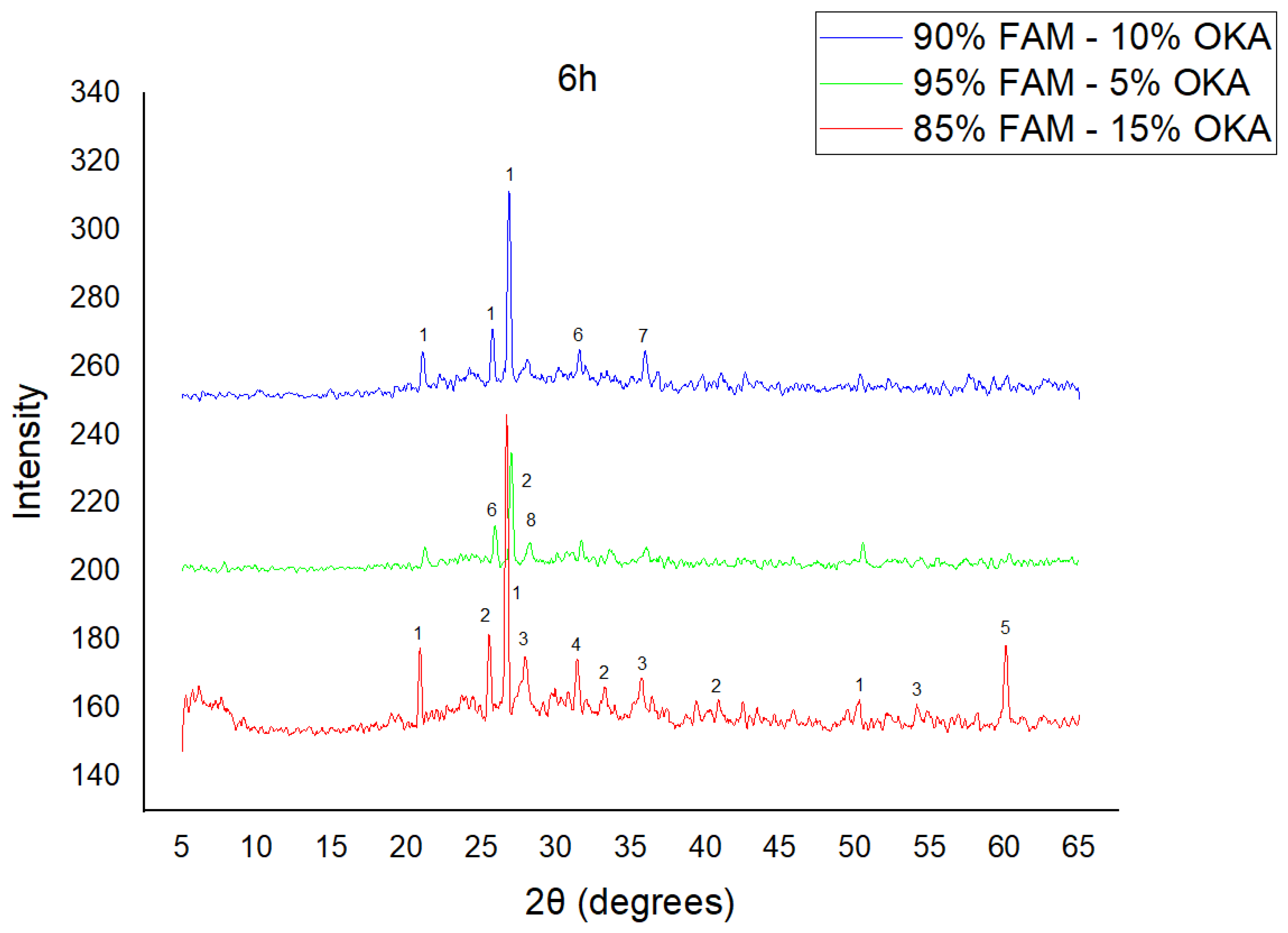
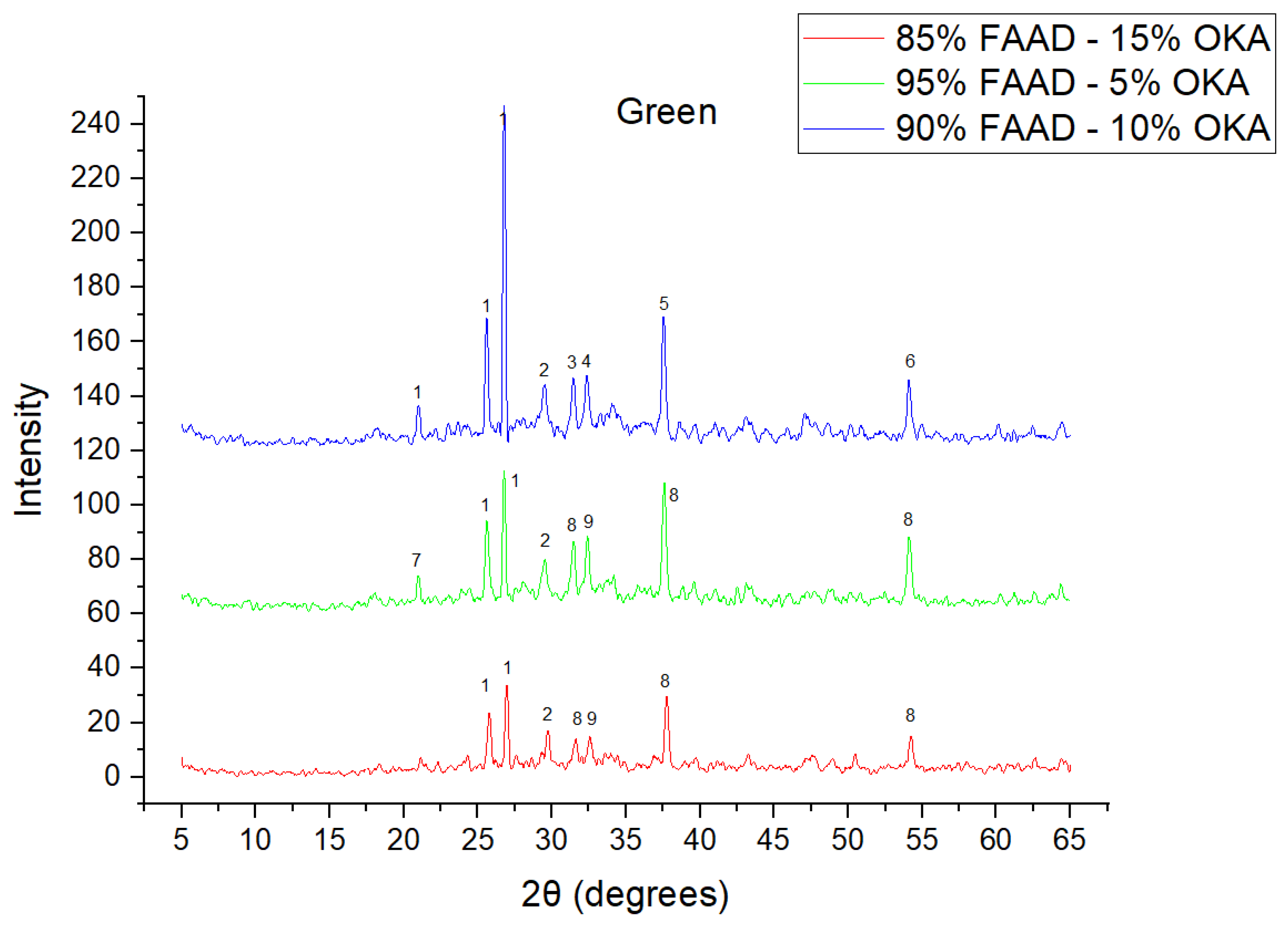
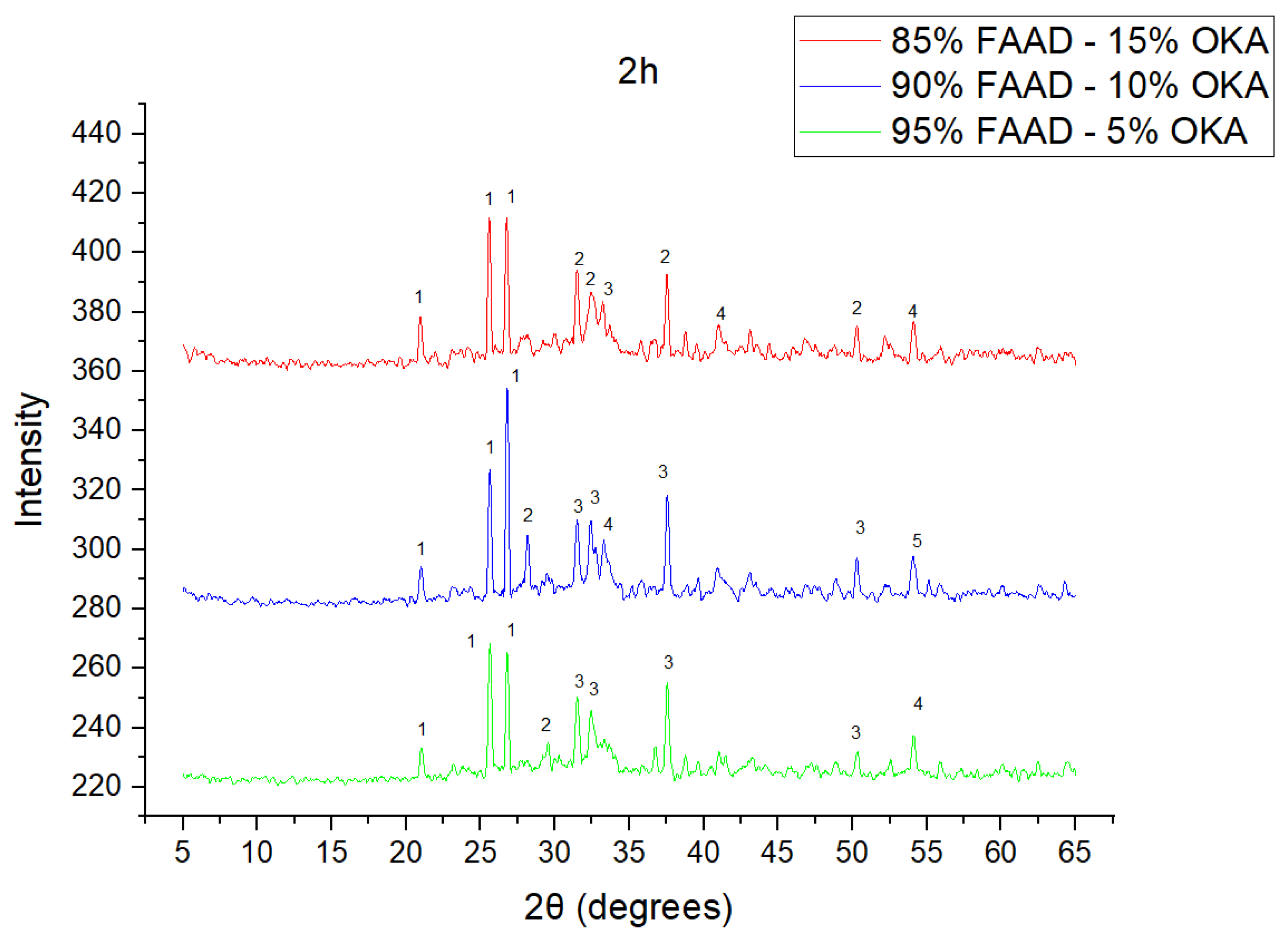


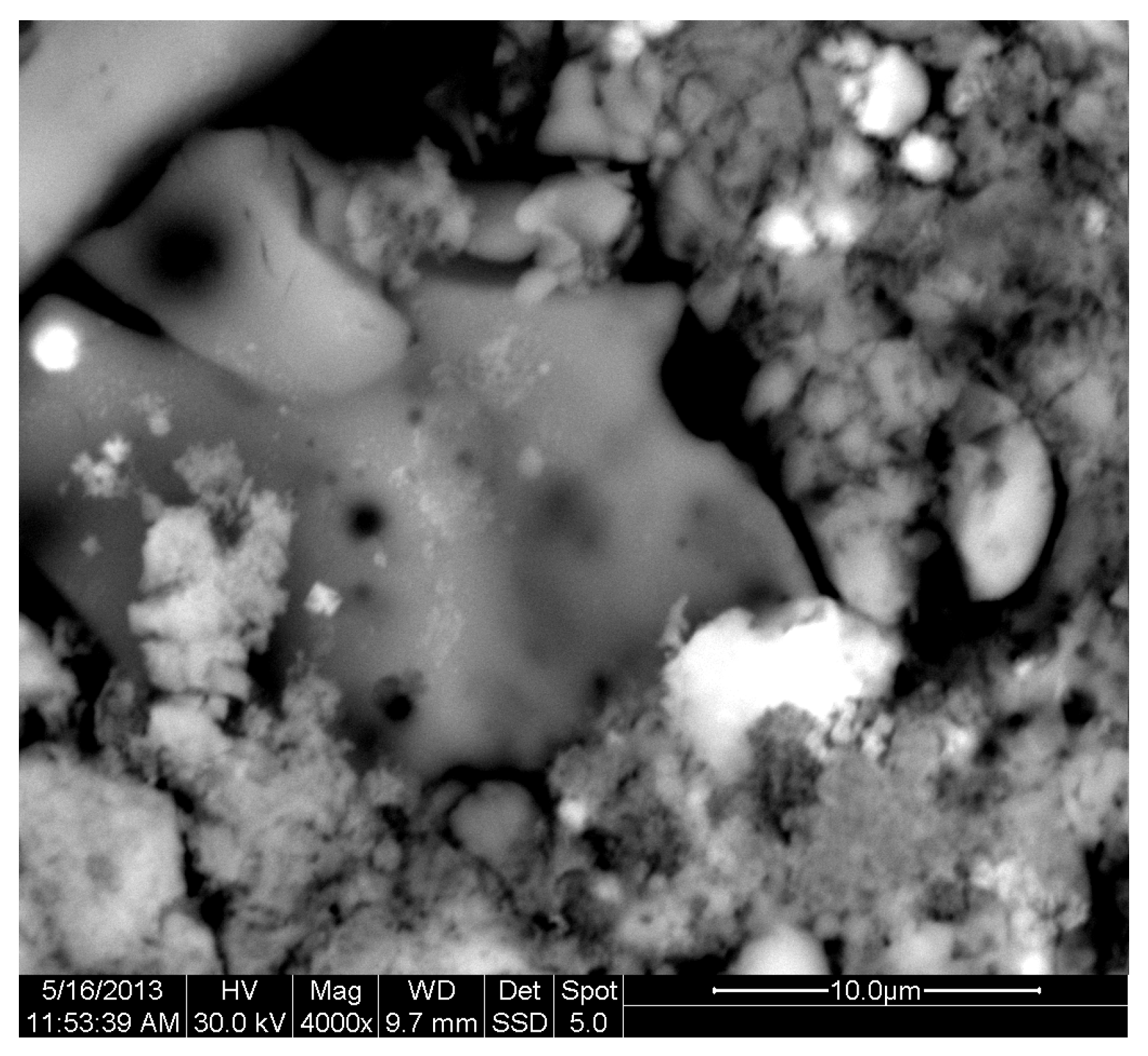
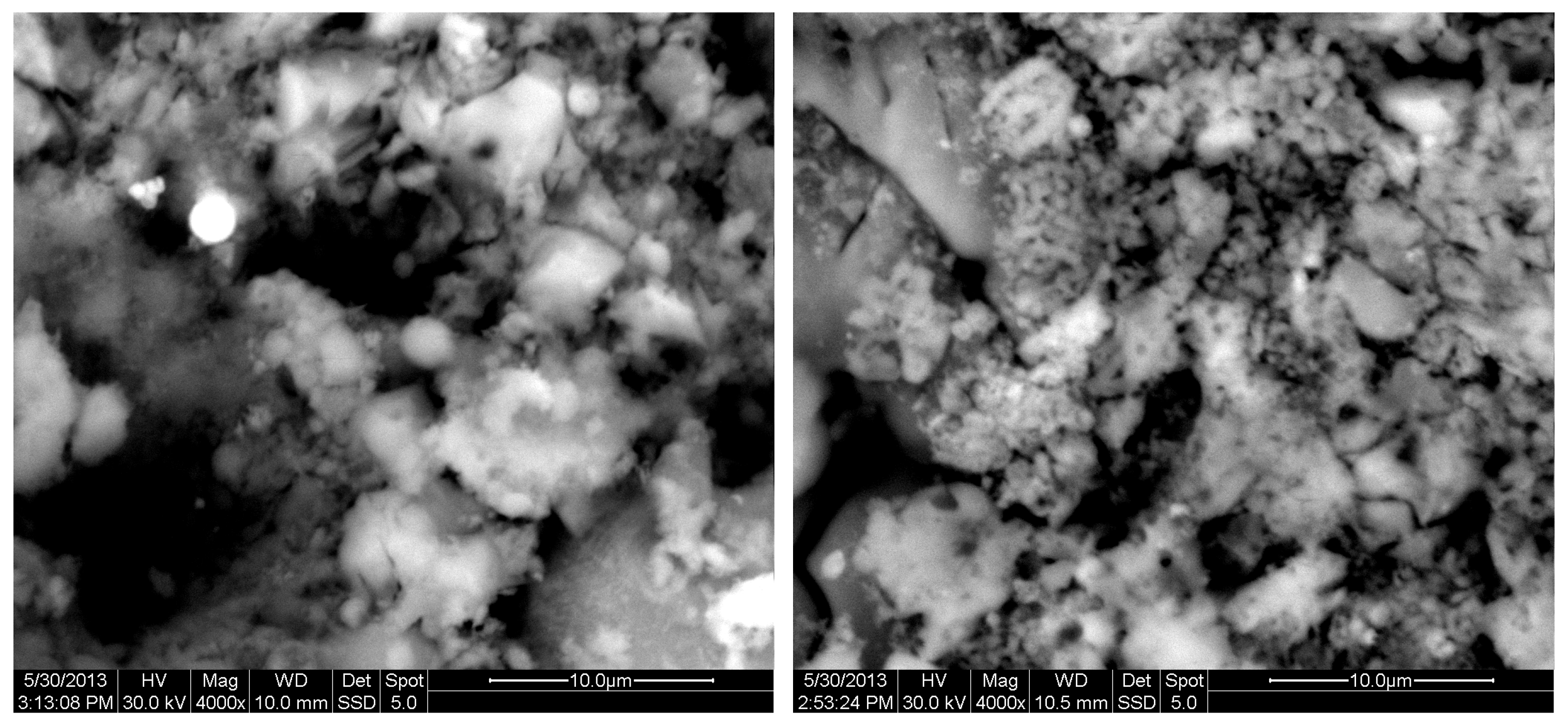


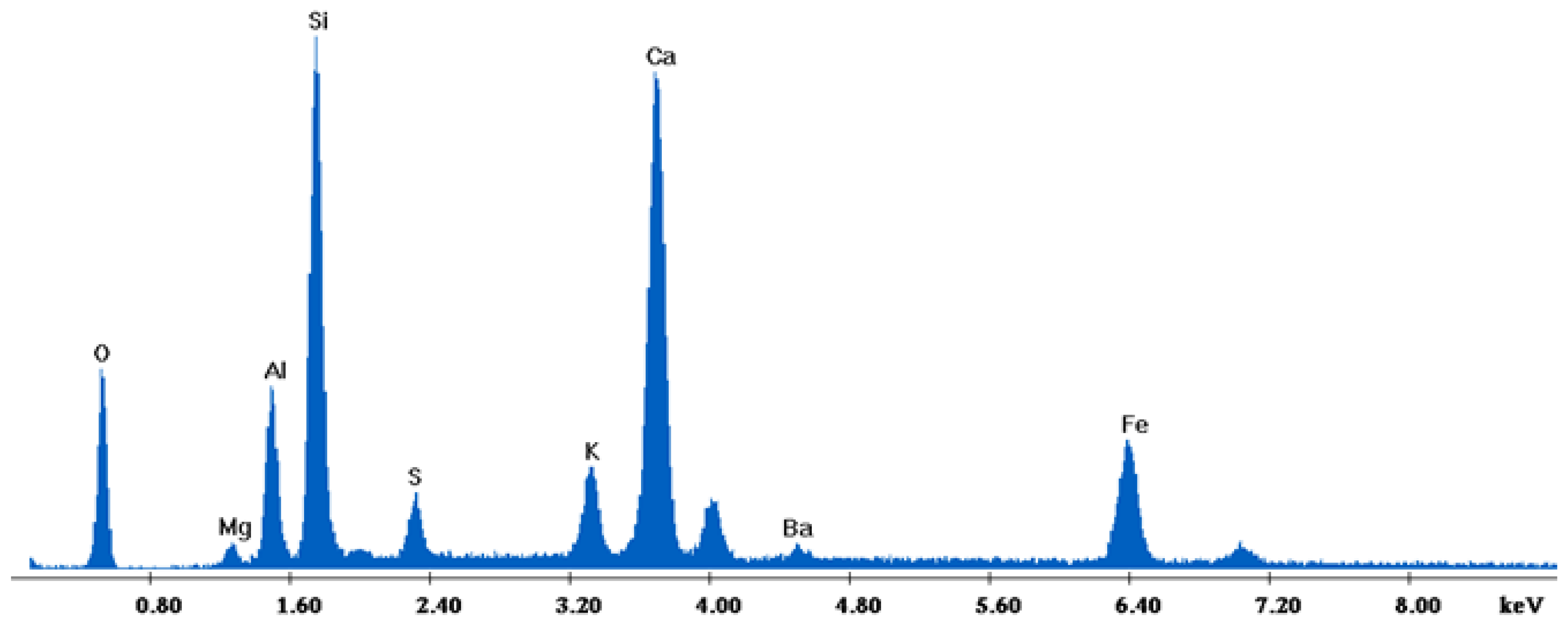
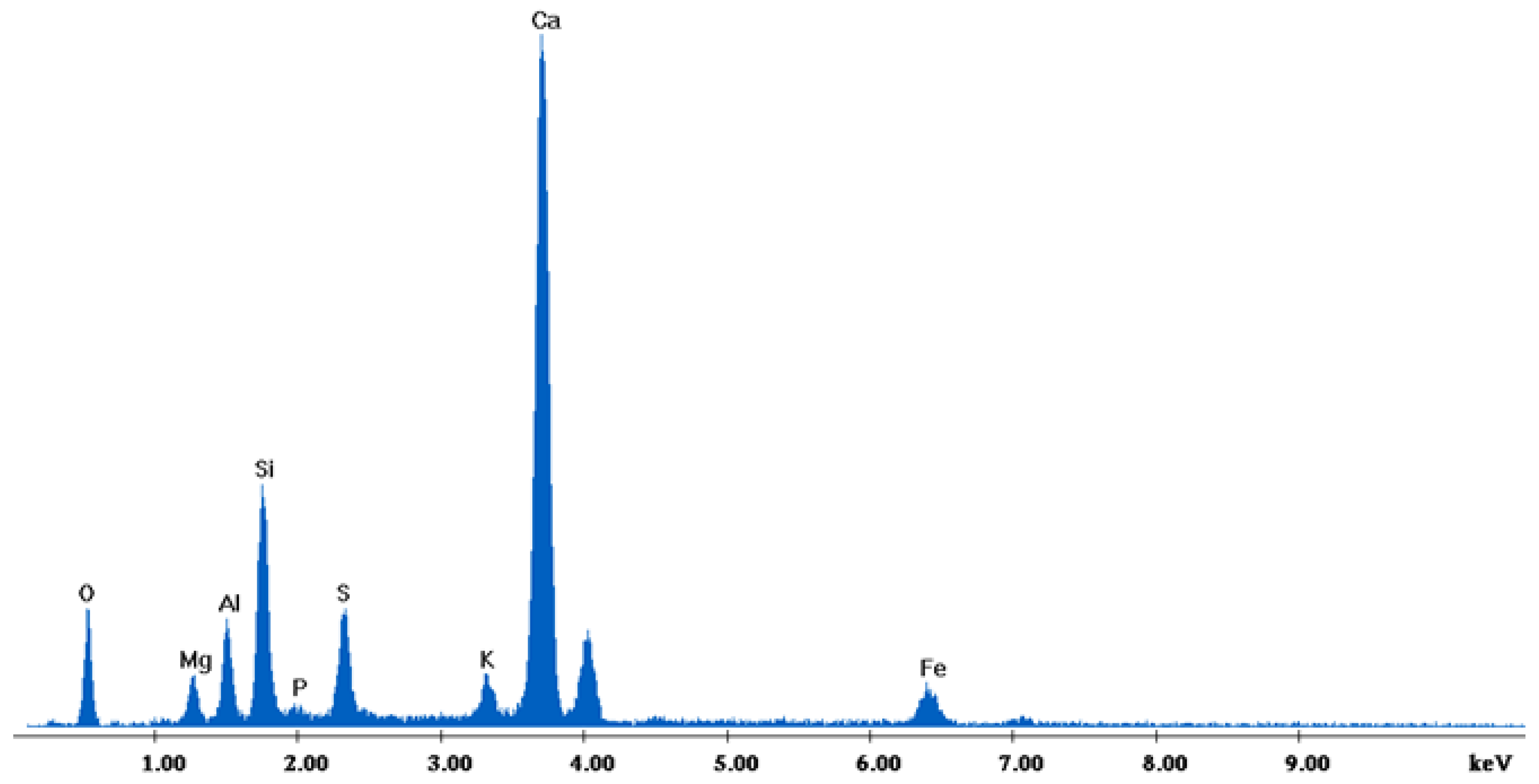

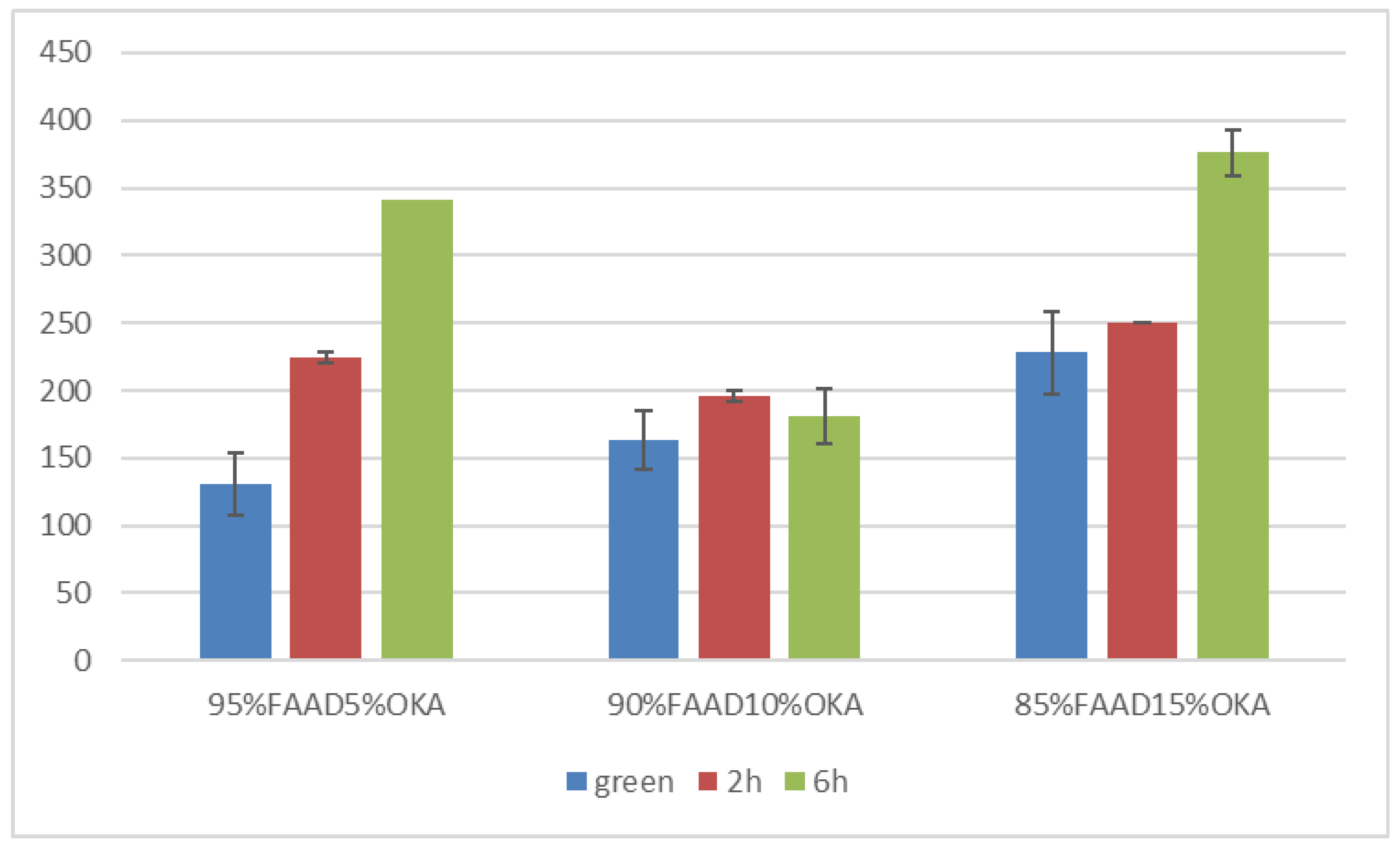
| Component | SiO2 | Al2O3 | Fe2O3 | CaO | MgO | K2O | Na2O | SO3 | TiO2 |
|---|---|---|---|---|---|---|---|---|---|
| FAAD (%) | 30.16 | 14.93 | 5.1 | 34.99 | 2.69 | 0.4 | 1.01 | 6.28 | - |
| FAM (%) | 49.54 | 19.25 | 8.44 | 11.82 | 2.27 | 1.81 | 0.53 | 3.91 | - |
| OKA (%) | 32.6 | 3.1 | 1.9 | 10.2 | 3.8 | 27.2 | 4.2 | 5.0 | 0.1 |
| FA Content (%wt) | OKA Content (%wt) | Sintering Duration (h) | Sintering Temperature (°C) | Applied Pressure (ΜPa) | Diameter (mm2) | |
|---|---|---|---|---|---|---|
| 95%FAAD5%OKA | 95 | 5 | 2 | 800 | 700 | 13 |
| 95%FAAD5%OKA | 95 | 5 | 6 | 800 | 700 | 13 |
| 95%FAM5%OKA | 95 | 5 | 2 | 800 | 700 | 13 |
| 95%FAM5%OKA | 95 | 5 | 6 | 800 | 700 | 13 |
| 90%FAAD10%OKA | 90 | 10 | 2 | 800 | 700 | 13 |
| 90%FAAD10%OKA | 90 | 10 | 6 | 800 | 700 | 13 |
| 90%FAM10%OKA | 90 | 10 | 2 | 800 | 700 | 13 |
| 90%FAM10%OKA | 90 | 10 | 6 | 800 | 700 | 13 |
| 85%FAAD15%OKA | 85 | 15 | 2 | 800 | 700 | 13 |
| 85%FAAD15%OKA | 85 | 15 | 6 | 800 | 700 | 13 |
| 85%FAM15%OKA | 85 | 15 | 2 | 800 | 700 | 13 |
| 85%FAM15%OKA | 85 | 15 | 6 | 800 | 700 | 13 |
| Green 95%FA5%OKA | 95 | 15 | - | - | 700 | 13 |
| Green 90%FA10%OKA | 90 | 10 | - | - | 700 | 13 |
| Green 85%FA15%OKA | 85 | 15 | - | - | 700 | 13 |
| Element | Wt% | At% | K-Ratio | Z | A | F |
|---|---|---|---|---|---|---|
| C | 6.75 | 12.78 | 0.0198 | 1.0591 | 0.2761 | 1.0007 |
| O | 39.10 | 55.54 | 0.0618 | 1.0412 | 0.1518 | 1.0002 |
| Na | 0.70 | 0.70 | 0.0021 | 0.9743 | 0.3055 | 1.0014 |
| Mg | 2.00 | 1.87 | 0.0087 | 0.9987 | 0.4360 | 1.0023 |
| Al | 1.17 | 0.98 | 0.0064 | 0.9692 | 0.5649 | 1.0041 |
| Si | 3.42 | 2.77 | 0.0235 | 0.9974 | 0.6860 | 1.0058 |
| P | 1.42 | 1.04 | 0.0105 | 0.9635 | 0.7618 | 1.0094 |
| Cl | 0.24 | 0.16 | 0.0021 | 0.9428 | 0.8843 | 1.0279 |
| K | 8.52 | 4.95 | 0.0814 | 0.9480 | 0.9574 | 1.0534 |
| Ca | 30.11 | 17.07 | 0.2745 | 0.9701 | 0.9385 | 1.0016 |
| Fe | 3.20 | 1.30 | 0.0275 | 0.8826 | 0.9679 | 1.0039 |
| Cu | 1.95 | 0.70 | 0.0164 | 0.8530 | 0.9867 | 1.0015 |
| S | 1.41 | 0.16 | 0.0091 | 0.6266 | 1.0226 | 1.0000 |
| Element | Wt% | At% | K-Ratio | Z | A | F |
|---|---|---|---|---|---|---|
| O | 37.09 | 56.27 | 0.0615 | 1.0400 | 0.1594 | 1.0005 |
| Mg | 1.06 | 1.05 | 0.0032 | 1.0024 | 0.3028 | 1.0068 |
| Al | 6.40 | 5.76 | 0.0260 | 0.9739 | 0.4134 | 1.0099 |
| Si | 20.18 | 17.44 | 0.0978 | 1.0033 | 0.4808 | 1.0044 |
| S | 2.25 | 1.70 | 0.0122 | 0.9969 | 0.5401 | 1.0102 |
| K | 3.29 | 2.05 | 0.0263 | 0.9554 | 0.8068 | 1.0367 |
| Ca | 18.96 | 11.48 | 0.1568 | 0.9775 | 0.8408 | 1.0065 |
| Ba | 1.69 | 0.30 | 0.0129 | 0.7714 | 0.9802 | 1.0107 |
| Fe | 9.08 | 3.95 | 0.0773 | 0.9022 | 0.9426 | 1.0000 |
| Element | Wt% | At% | K-Ratio | Z | A | F |
|---|---|---|---|---|---|---|
| O | 34.30 | 53.07 | 0.0433 | 1.0356 | 0.1219 | 1.0004 |
| Mg | 3.51 | 3.58 | 0.0112 | 0.9982 | 0.3170 | 1.0059 |
| Al | 4.82 | 4.42 | 0.0194 | 0.9698 | 0.4116 | 1.0089 |
| Si | 11.94 | 10.53 | 0.0597 | 0.9990 | 0.4961 | 1.0081 |
| P | 1.04 | 0.83 | 0.0051 | 0.9668 | 0.4995 | 1.0127 |
| S | 5.04 | 3.89 | 0.0310 | 0.9927 | 0.6093 | 1.0164 |
| K | 2.06 | 1.30 | 0.0174 | 0.9512 | 0.8335 | 1.0643 |
| Ca | 33.55 | 20.72 | 0.2855 | 0.9732 | 0.8725 | 1.0019 |
| Fe | 3.73 | 1.66 | 0.0309 | 0.8983 | 0.9200 | 1.0000 |
Disclaimer/Publisher’s Note: The statements, opinions and data contained in all publications are solely those of the individual author(s) and contributor(s) and not of MDPI and/or the editor(s). MDPI and/or the editor(s) disclaim responsibility for any injury to people or property resulting from any ideas, methods, instructions or products referred to in the content. |
© 2025 by the authors. Licensee MDPI, Basel, Switzerland. This article is an open access article distributed under the terms and conditions of the Creative Commons Attribution (CC BY) license (https://creativecommons.org/licenses/by/4.0/).
Share and Cite
Moutsatsou, A.; Katsika, E.; Flegkas, D.; Pagonis, N.; Drosou, C.-A.; Itziou, A.; Karayannis, V. Development of Novel Ceramic Microstructures from Sintered Biomass and Fly Ash Mixtures: Promoting Sustainability and Health. Materials 2025, 18, 1496. https://doi.org/10.3390/ma18071496
Moutsatsou A, Katsika E, Flegkas D, Pagonis N, Drosou C-A, Itziou A, Karayannis V. Development of Novel Ceramic Microstructures from Sintered Biomass and Fly Ash Mixtures: Promoting Sustainability and Health. Materials. 2025; 18(7):1496. https://doi.org/10.3390/ma18071496
Chicago/Turabian StyleMoutsatsou, Angeliki, Eleni Katsika, Dimitrios Flegkas, Nikolaos Pagonis, Christina-Amalia Drosou, Aikaterini Itziou, and Vayos Karayannis. 2025. "Development of Novel Ceramic Microstructures from Sintered Biomass and Fly Ash Mixtures: Promoting Sustainability and Health" Materials 18, no. 7: 1496. https://doi.org/10.3390/ma18071496
APA StyleMoutsatsou, A., Katsika, E., Flegkas, D., Pagonis, N., Drosou, C.-A., Itziou, A., & Karayannis, V. (2025). Development of Novel Ceramic Microstructures from Sintered Biomass and Fly Ash Mixtures: Promoting Sustainability and Health. Materials, 18(7), 1496. https://doi.org/10.3390/ma18071496







